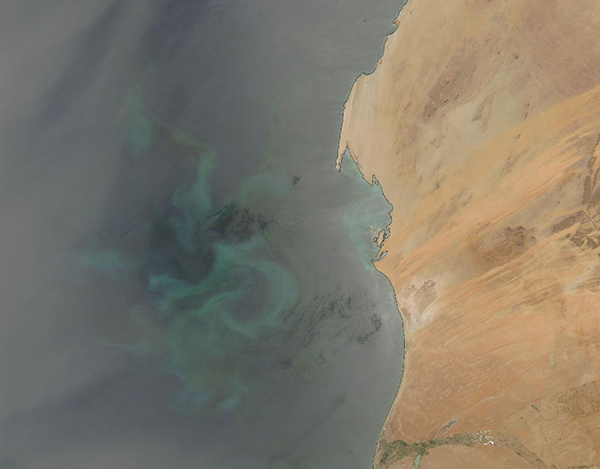Images
April 21, 2024 - Dust and Phytoplankton off Africa
Tweet
Jewel-toned ocean swirls and dust-laden skies greeted NASA’s Aqua satellite on April 17, 2024, allowing the Moderate Resolution Imaging Spectroradiometer (MODIS) on board to acquire this stunning true-color image.
The colorful waters mark the location of a floating bloom of phytoplankton in the Atlantic Ocean off the coast of Mauritania. Phytoplankton are microscopic plant-like organisms that live in ocean waters year-round in smaller numbers. When conditions are right (adequate sunlight, favorable water temperatures, and abundant nutrients), phytoplankton can reproduce explosively to create large floating blooms that can easily be seen from space.
Phytoplankton usually receive their nutrients from mineral nutrients that well up from ocean depths or that are washed into the ocean from coastal runoff. But mineral-rich desert dust can also provide abundant nutrients for phytoplankton.
The tan haze in this image comes from just one in a series of dust storms that have carried dust from the Sahara Desert over the Atlantic Ocean in the last several months. The dust carries iron, which has been thought to be the critical nutrient needed to spur phytoplankton growth in many iron-poor areas of the world’s oceans. But dust also contains many other nutrients that the plant-like organisms need, notably phosphorus and nitrogen.
Image Facts
Satellite:
Aqua
Date Acquired: 4/17/2024
Resolutions:
1km (45.3 KB), 500m (145.9 KB), 250m (456.5 KB)
Bands Used: 1,4,3
Image Credit:
MODIS Land Rapid Response Team, NASA GSFC
Tweet
Jewel-toned ocean swirls and dust-laden skies greeted NASA’s Aqua satellite on April 17, 2024, allowing the Moderate Resolution Imaging Spectroradiometer (MODIS) on board to acquire this stunning true-color image.
The colorful waters mark the location of a floating bloom of phytoplankton in the Atlantic Ocean off the coast of Mauritania. Phytoplankton are microscopic plant-like organisms that live in ocean waters year-round in smaller numbers. When conditions are right (adequate sunlight, favorable water temperatures, and abundant nutrients), phytoplankton can reproduce explosively to create large floating blooms that can easily be seen from space.
Phytoplankton usually receive their nutrients from mineral nutrients that well up from ocean depths or that are washed into the ocean from coastal runoff. But mineral-rich desert dust can also provide abundant nutrients for phytoplankton.
The tan haze in this image comes from just one in a series of dust storms that have carried dust from the Sahara Desert over the Atlantic Ocean in the last several months. The dust carries iron, which has been thought to be the critical nutrient needed to spur phytoplankton growth in many iron-poor areas of the world’s oceans. But dust also contains many other nutrients that the plant-like organisms need, notably phosphorus and nitrogen.
Image Facts
Satellite:
Aqua
Date Acquired: 4/17/2024
Resolutions:
1km (45.3 KB), 500m (145.9 KB), 250m (456.5 KB)
Bands Used: 1,4,3
Image Credit:
MODIS Land Rapid Response Team, NASA GSFC




